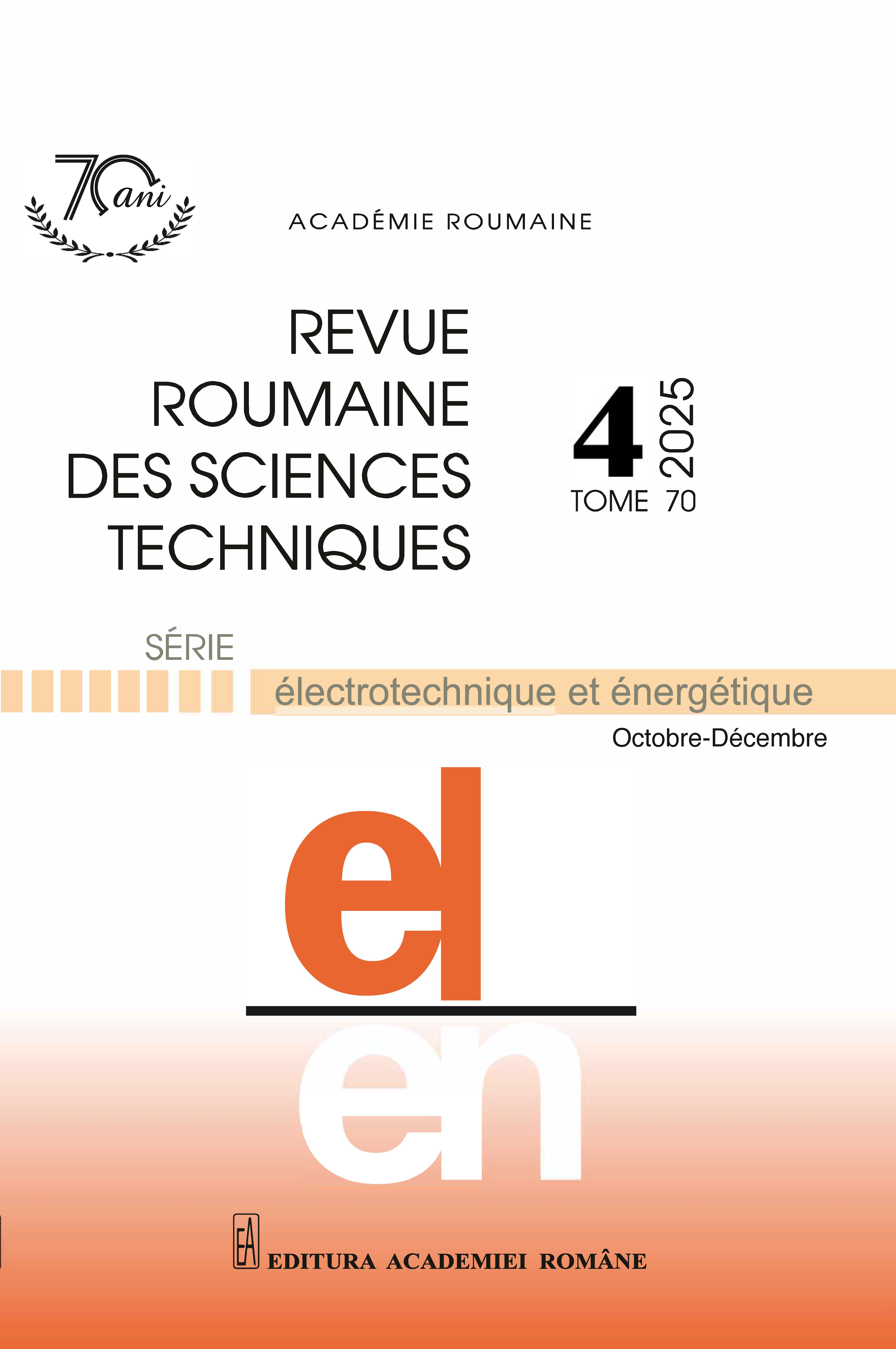CONTRÔLE ET MISE EN ŒUVRE D'UN MINI-CONCENTRATEUR SOLAIRE CYLINDRIQUE-PARABOLIQUE
DOI :
https://doi.org/10.59277/RRST-EE.2025.4.6Mots-clés :
Solar concentration, Solar tracking, Stepper motor, Automatic control, Light Dependent ResistorsRésumé
Cette recherche présente la conception et la mise en œuvre d'un système de concentration solaire à l'aide d'un concentrateur solaire parabolique cylindrique. Le système est conçu pour capter et concentrer la lumière solaire sur un tube contenant un fluide caloporteur. La chaleur ainsi produite est exploitée pour générer de la vapeur, qui alimente ensuite une turbine à vapeur afin de produire de l'électricité. Un mécanisme de suivi solaire garantit des performances optimales du système tout au long de la journée. Le cœur du système de concentration comprend un moteur pas à pas intégré à la structure mécanique, dont la communication est facilitée par une carte Arduino et MATLAB. Le contrôle du concentrateur solaire est mis en œuvre à l'aide de deux stratégies distinctes. La première est un contrôle automatique basé sur des résistances dépendantes de la lumière (LDR), utilisées pour déterminer la position du soleil. Ces données sont transmises au système de contrôle, qui permet d’ajuster automatiquement l’orientation et le positionnement du concentrateur solaire parabolique. La seconde est une commande manuelle basée sur une interface utilisateur graphique (GUI) de MATLAB, développée pour permettre le contrôle manuel du moteur pas à pas du concentrateur solaire. Cet article examine la relation complexe entre la précision de la commande, l'erreur et le nombre de pas du moteur.
Références
(1) K. Benmouiza, Nonlinear clustered adaptive-network-based fuzzy inference system model for hourly solar irradiation estimation, Rev. Roum. Sci. Techn. – Électrotechn. et Énerg., 68, 1, pp. 7–11 (2023).
(2) S.M. Ulaganathan, R. Muniraj, R. Vijayanand, and D. Devaraj, Novel solar photovoltaic emulation for validating the maximum power point algorithm and power converter, Rev. Roum. Sci. Techn. – Électrotechn. et Énerg., 68, 4, pp. 407–412 (2023).
(3) G.G. Tolun and Y.A. Kaplan, Development of backpropagation algorithm for estimating solar radiation: a case study in Turkey, Rev. Roum. Sci. Techn. – Électrotechn. et Énerg., 68, 3, pp. 313–316 (2023).
(4) V.G. Dogaru, F.D. Dogaru, V. Năvrăpescu, and L.M. Constantinescu, From the photovoltaic effect to a low voltage photovoltaic grid challenge – a review, Rev. Roum. Sci. Techn. – Électrotechn. et Énerg., 69, 3, pp. 263–268 (2024).
(5) M.I. Abdelwanis and A.A. Zakymaximum, Maximum power point tracking in a perovskite solar pumping system with a six-phase induction motor, Rev. Roum. Sci. Techn. – Électrotechn. et Énerg., 69, 1, pp. 15–20 (2024).
(6) S. Seba, M. Birane, and K. Benmouiza, A comparative analysis of boost converter topologies for photovoltaic systems using MPPT (PO) and beta methods under partial shading, Rev. Roum. Sci. Techn. – Électrotechn. et Énerg., 68, 4, pp. 375–380 (2023).
(7) A.H. Alami, A.G. Olabi, A. Mdallal, A. Rezk, A. Radwan, S.M.A. Rahman, and M.A. Abdelkareem, Concentrating solar power (CSP) technologies: Status and analysis, International Journal of Thermofluids, 18, 100340 (2023).
(8) A. Gama, M. Haddadi, and A. Malek, Étude et réalisation d’un concentrateur cylindro-parabolique avec poursuite solaire aveugle, Journal of Renewable Energies, 11, 3, pp. 437–451 (2008).
(9) W.E. Sánchez, M.P. Jiménez, C.A. Mantilla, J.M. Toro, M.A. Villa, and G. Sinchiguano, Design and implementation of a parabolic cylinder collector with solar tracking to obtain hot water, In E3S Web of Conferences, Vol. 57, 02003, EDP Sciences (2018).
(10) A.K. Bhakta, N.K. Panday, and S.N. Singh, Performance study of a cylindrical parabolic concentrating solar water heater with nail-type twisted tape inserts in the copper absorber tube, Energies, 11, 1, 204 (2018).
(11) A. Gama, C. Larbes, A. Malek, and F. Yettou, Etude et réalisation d’un dispositif de poursuite solaire sensible destiné à un prototype d’un concentrateur cylindro-parabolique, Revue des sciences fondamentales et appliquées, 2, 1, pp. 137–148 (2010).
(12) Y.D. Arbuzov, V.M. Evdokimov, and O.V. Shepovalova, Theory of concentration distribution over the surface of axisymmetrical receiver in cylindrical parabolic mirror solar energy concentrator, Energy Reports, 6, pp. 380–394 (2020).
(13) N. Nouah, N. Djennaoui, and T. Hassani, Modélisation d’un capteur solaire cylindro-parabolique, Journal of Renewable Energies, 17, 4, pp. 559–567 (2014).
(14) S. Niyonsaba and J.B. Niyonzima, Design and sizing of a solar thermal power plant with parabolic trough collectors, Journal of Renewable Energies, 27, 1, pp. 81–98 (2024).
(15) A. Messai, Y. Benkedda, S. Bouaichaoui, and M. Benzerga, Feasibility study of parabolic trough solar power plant under Algerian climate, Energy Procedia, 42, pp. 73–82 (2013).
(16) A.B. Sproul, Derivation of the solar geometric relationships using vector analysis, Renewable Energy, 32, pp. 1187–1205 (2007).
(17) J.A. Duffie and W.A. Beckman, Solar engineering of thermal processes, 2nd ed., Wiley & Sons, New York, NY (1991).
(18) J.E. Braun and J.C. Michell, Solar geometry for fixed and tracking surfaces, Solar Energy, 31, 5, pp. 439–444 (1983).
(19) M. Iqbal, An introduction to solar radiation, Academic Press, New York (1983).
(20) R. Kittler and S. Darula, Determination of time and sun position system, Solar Energy, 93, pp. 72–79 (2013).
(21) T. Muneer, Solar radiation & daylight models for the energy efficient design of buildings, Architectural Press, Oxford (1997).
(22) R. Buckner, Astronomic and grid azimuth, Landmark Enterprises, Rancho Cordova (1984).
(23) A.T. Ali, An error modeling framework for the Sun azimuth obtained at a location with the hour angle method, Positioning, 3, pp. 21–29 (2012).
(24) M.H.M. Sidek, N. Azis, W.Z.W. Hasan, M.Z.A. Ab Kadir, S. Shafie, and M.A.M. Radzi, Automated positioning dual-axis solar tracking system with precision elevation and azimuth angle control, Energy, 124, pp. 160–170 (2017).
Téléchargements
Publiée
Numéro
Rubrique
Licence
(c) Copyright REVUE ROUMAINE DES SCIENCES TECHNIQUES — SÉRIE ÉLECTROTECHNIQUE ET ÉNERGÉTIQUE 2025

Ce travail est disponible sous licence Creative Commons Attribution - Pas d'Utilisation Commerciale - Pas de Modification 4.0 International.


